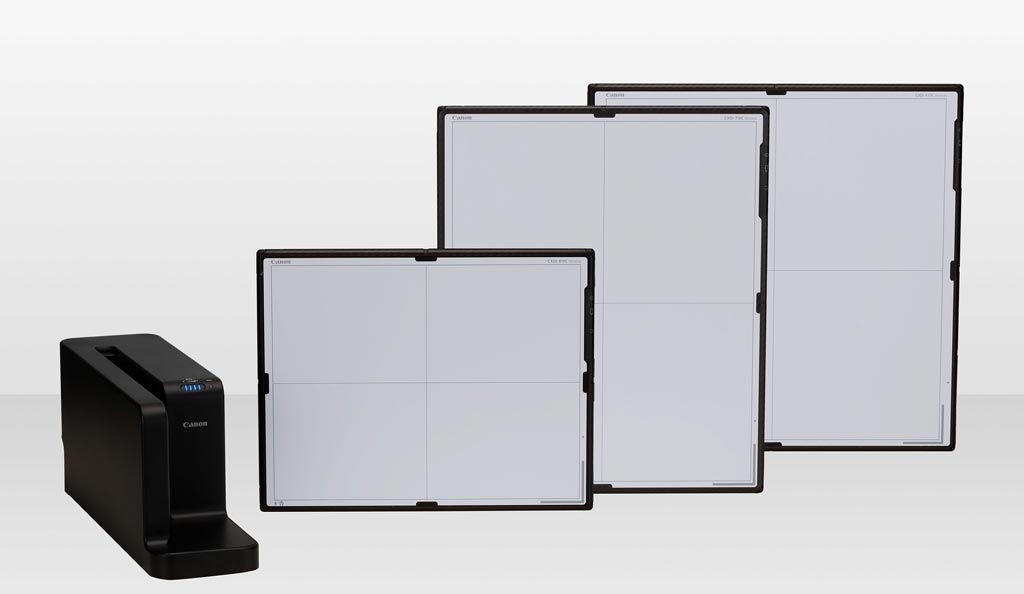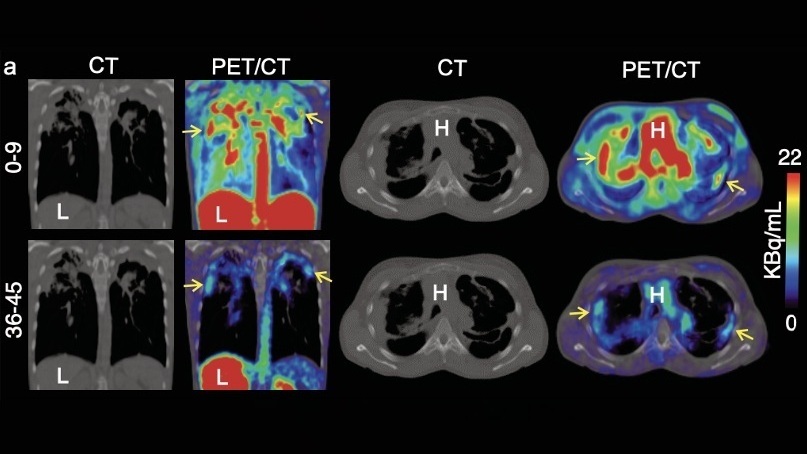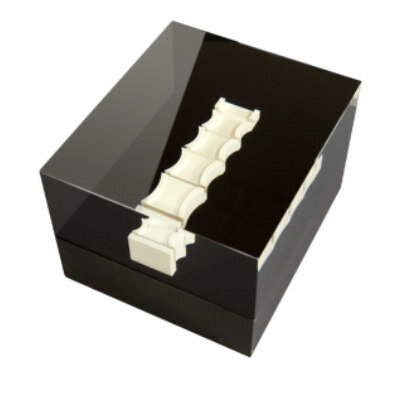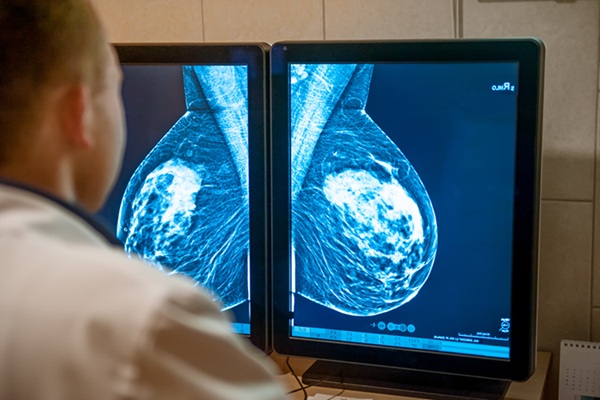Canon Showcases New DR Systems at Medical Imaging Fair
|
By MedImaging International staff writers Posted on 27 Nov 2017 |

Image: The CXDI-710C wireless detector (Photo courtesy of Canon).
Canon U.S.A., Inc. (Melville, NY, USA) provided a firsthand look at its refreshed lineup of CXDI digital radiography detectors to guests at the annual meeting of RSNA (Radiological Society of North America), held from November 26th through November 30th in Chicago, Illinois.
The company recently launched the CXDI-710C, CXDI-810C and CXDI-410C wireless detectors with beneficial features to help healthcare professionals streamline their digital X-ray process. The IPX7-rated detectors feature a strong carbon fiber chassis and frame, making them among the lightest weight detectors currently available. The ergonomic handgrips sculpted into the detectors make the devices comfortable to hold and easy to handle, while their smooth rounded corners allow for easy, comfortable positioning for patients and technologists.
Additionally, the new CXDI detectors feature a "Ready" function for use when working with multiple detectors in a single environment, allowing a specific detector to be selected from both the DR modality workstation by simply pressing the "Ready" button located directly on the detector or on an optional status indicator. The detectors are also equipped with limited, temporary on-board image storage capability when operated in standalone mode. The detectors come with a charger which can simultaneously charge up to two batteries at a time along with an optional docking station which allows for detector check-in, rapid battery charging while in detector, and transfer of images from the detector taken in standalone mode.
"Canon Inc. has a storied history of imaging excellence and this reputation is maintained throughout our entire product portfolio, including our diagnostic imaging devices," said Tsuneo Imai, vice president and general manager, Healthcare Solutions Division, Business Imaging Solutions Group, Canon U.S.A., Inc., and president, Virtual Imaging, Inc. "This superb quality, combined with the reliability expected from Canon devices, is prevalent in our new wireless detectors. These new devices were designed to help improve the overall experience of the patients and technologists."
The company recently launched the CXDI-710C, CXDI-810C and CXDI-410C wireless detectors with beneficial features to help healthcare professionals streamline their digital X-ray process. The IPX7-rated detectors feature a strong carbon fiber chassis and frame, making them among the lightest weight detectors currently available. The ergonomic handgrips sculpted into the detectors make the devices comfortable to hold and easy to handle, while their smooth rounded corners allow for easy, comfortable positioning for patients and technologists.
Additionally, the new CXDI detectors feature a "Ready" function for use when working with multiple detectors in a single environment, allowing a specific detector to be selected from both the DR modality workstation by simply pressing the "Ready" button located directly on the detector or on an optional status indicator. The detectors are also equipped with limited, temporary on-board image storage capability when operated in standalone mode. The detectors come with a charger which can simultaneously charge up to two batteries at a time along with an optional docking station which allows for detector check-in, rapid battery charging while in detector, and transfer of images from the detector taken in standalone mode.
"Canon Inc. has a storied history of imaging excellence and this reputation is maintained throughout our entire product portfolio, including our diagnostic imaging devices," said Tsuneo Imai, vice president and general manager, Healthcare Solutions Division, Business Imaging Solutions Group, Canon U.S.A., Inc., and president, Virtual Imaging, Inc. "This superb quality, combined with the reliability expected from Canon devices, is prevalent in our new wireless detectors. These new devices were designed to help improve the overall experience of the patients and technologists."
Latest RSNA 2017 News
- Siemens Healthineers Launches New Mammography System at RSNA
- New Real-Time Imaging AI Platform Unveiled
- Bracco Diagnostics Highlights Advancement in Diagnostic Imaging Portfolio
- Varex Imaging Showcases New X-ray Components at Trade Fair
- Samsung Unveils New Mobile CT at RSNA 2017
- Thales Unveils World’s First Portable Detector with Embedded Patient ID
- PACSHealth Showcases DoseMonitor Upgrade at Chicago Trade Show
- Carestream Exhibits New Diagnostic Imaging Solutions in Chicago
- Siemens Healthineers Spotlights Advances in Breast Imaging
- Agfa HealthCare Presents Advances in AI and Machine Learning at RSNA 2017
- Philips Showcases New Imaging Systems and Informatics Portfolio at RSNA
- Fujifilm Debuts New FDR Go PLUS Version Portable System
- Aspect Imaging Presents Neonatal MRI System at RSNA 2017
- Visage Imaging Debuts AI Offerings at Chicago Show
- Carestream Joins Zebra Medical Vision to Provide Access to AI Algorithms
Channels
Radiography
view channel
AI Generates Future Knee X-Rays to Predict Osteoarthritis Progression Risk
Osteoarthritis, a degenerative joint disease affecting over 500 million people worldwide, is the leading cause of disability among older adults. Current diagnostic tools allow doctors to assess damage... Read more
AI Algorithm Uses Mammograms to Accurately Predict Cardiovascular Risk in Women
Cardiovascular disease remains the leading cause of death in women worldwide, responsible for about nine million deaths annually. Despite this burden, symptoms and risk factors are often under-recognized... Read moreMRI
view channel
AI-Assisted Model Enhances MRI Heart Scans
A cardiac MRI can reveal critical information about the heart’s function and any abnormalities, but traditional scans take 30 to 90 minutes and often suffer from poor image quality due to patient movement.... Read more
AI Model Outperforms Doctors at Identifying Patients Most At-Risk of Cardiac Arrest
Hypertrophic cardiomyopathy is one of the most common inherited heart conditions and a leading cause of sudden cardiac death in young individuals and athletes. While many patients live normal lives, some... Read moreUltrasound
view channel
Ultrasound Probe Images Entire Organ in 4D
Disorders of blood microcirculation can have devastating effects, contributing to heart failure, kidney failure, and chronic diseases. However, existing imaging technologies cannot visualize the full network... Read more
Disposable Ultrasound Patch Performs Better Than Existing Devices
Wearable ultrasound devices are widely used in diagnostics, rehabilitation monitoring, and telemedicine, yet most existing models rely on lead-based piezoelectric ceramics that pose health and environmental risks.... Read moreNuclear Medicine
view channel
New Imaging Solution Improves Survival for Patients with Recurring Prostate Cancer
Detecting recurrent prostate cancer remains one of the most difficult challenges in oncology, as standard imaging methods such as bone scans and CT scans often fail to accurately locate small or early-stage tumors.... Read more
PET Tracer Enables Same-Day Imaging of Triple-Negative Breast and Urothelial Cancers
Triple-negative breast cancer (TNBC) and urothelial bladder carcinoma (UBC) are aggressive cancers often diagnosed at advanced stages, leaving limited time for effective treatment decisions.... Read more
New Camera Sees Inside Human Body for Enhanced Scanning and Diagnosis
Nuclear medicine scans like single-photon emission computed tomography (SPECT) allow doctors to observe heart function, track blood flow, and detect hidden diseases. However, current detectors are either... Read more
Novel Bacteria-Specific PET Imaging Approach Detects Hard-To-Diagnose Lung Infections
Mycobacteroides abscessus is a rapidly growing mycobacteria that primarily affects immunocompromised patients and those with underlying lung diseases, such as cystic fibrosis or chronic obstructive pulmonary... Read moreGeneral/Advanced Imaging
view channel
AI Tool Improves Medical Imaging Process by 90%
Accurately labeling different regions within medical scans, a process known as medical image segmentation, is critical for diagnosis, surgery planning, and research. Traditionally, this has been a manual... Read more
New Ultrasmall, Light-Sensitive Nanoparticles Could Serve as Contrast Agents
Medical imaging technologies face ongoing challenges in capturing accurate, detailed views of internal processes, especially in conditions like cancer, where tracking disease development and treatment... Read more
AI Algorithm Accurately Predicts Pancreatic Cancer Metastasis Using Routine CT Images
In pancreatic cancer, detecting whether the disease has spread to other organs is critical for determining whether surgery is appropriate. If metastasis is present, surgery is not recommended, yet current... Read moreImaging IT
view channel
New Google Cloud Medical Imaging Suite Makes Imaging Healthcare Data More Accessible
Medical imaging is a critical tool used to diagnose patients, and there are billions of medical images scanned globally each year. Imaging data accounts for about 90% of all healthcare data1 and, until... Read more
Global AI in Medical Diagnostics Market to Be Driven by Demand for Image Recognition in Radiology
The global artificial intelligence (AI) in medical diagnostics market is expanding with early disease detection being one of its key applications and image recognition becoming a compelling consumer proposition... Read moreIndustry News
view channel
GE HealthCare and NVIDIA Collaboration to Reimagine Diagnostic Imaging
GE HealthCare (Chicago, IL, USA) has entered into a collaboration with NVIDIA (Santa Clara, CA, USA), expanding the existing relationship between the two companies to focus on pioneering innovation in... Read more
Patient-Specific 3D-Printed Phantoms Transform CT Imaging
New research has highlighted how anatomically precise, patient-specific 3D-printed phantoms are proving to be scalable, cost-effective, and efficient tools in the development of new CT scan algorithms... Read more
Siemens and Sectra Collaborate on Enhancing Radiology Workflows
Siemens Healthineers (Forchheim, Germany) and Sectra (Linköping, Sweden) have entered into a collaboration aimed at enhancing radiologists' diagnostic capabilities and, in turn, improving patient care... Read more





















